monsterrack
Silver Member
- Apr 15, 2013
- 4,419
- 5,819
- Detector(s) used
- Garrett, and Whites
- Primary Interest:
- All Treasure Hunting
First let me say I'm glad that folks that are new to this hobby have joined and for a plug for this site become a full member. 2nd I have made other post like this before like Points for Newbies so go back and look for them. Sitting at home taken care of the wife after an operation and thought I would post this. 1st is learning what is worked stone and natural broken stone. This 1st and 2nd photo is of a natural broken rock.
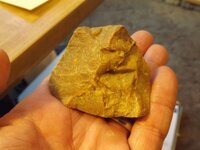
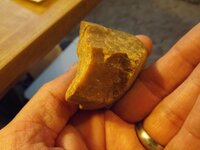 . The next photo if you picked it up from the 1st view you would think it's just a rock, but when you turn it over you see the pattern that knapping makes.
. The next photo if you picked it up from the 1st view you would think it's just a rock, but when you turn it over you see the pattern that knapping makes.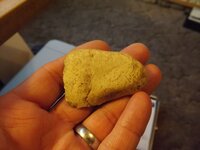
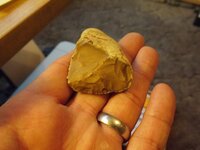 This next photo is just a bag of stone scrapers I had in my office(I have buckets full) You can see they are flaked all the way around and most were made for a one time use or to be used for a short period of time.
This next photo is just a bag of stone scrapers I had in my office(I have buckets full) You can see they are flaked all the way around and most were made for a one time use or to be used for a short period of time.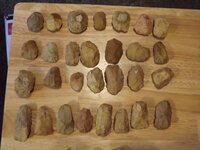 Now every now an then you will find a tool that has a wear pattern just jump out at you, like this scraper.
Now every now an then you will find a tool that has a wear pattern just jump out at you, like this scraper.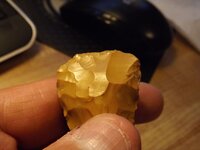 It took a lot of use to get this shine on the blade end of this tool. This was not put there by water flow or heating the stone it took a many a stroke to get this type of use wear on a thumb scraper. Next hammers stones will always have the sign of the constant impact on a end or all over. This next photo will show that and before anyone say's it those are plow marks on that one small hammer stone.
It took a lot of use to get this shine on the blade end of this tool. This was not put there by water flow or heating the stone it took a many a stroke to get this type of use wear on a thumb scraper. Next hammers stones will always have the sign of the constant impact on a end or all over. This next photo will show that and before anyone say's it those are plow marks on that one small hammer stone.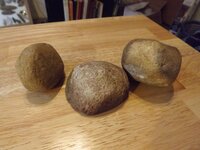 One more thing just because you find a item in a field or creek, on a hill or on a mound, it does not mean it is a 100% artifact. Only when you find something in contex and that means only if you dig and find items like artifacts in the same layer of occupation can you say that it was used or put there at that time period by those people. look back on some of my old post and I hope they may help you in some way.
One more thing just because you find a item in a field or creek, on a hill or on a mound, it does not mean it is a 100% artifact. Only when you find something in contex and that means only if you dig and find items like artifacts in the same layer of occupation can you say that it was used or put there at that time period by those people. look back on some of my old post and I hope they may help you in some way.

 . The next photo if you picked it up from the 1st view you would think it's just a rock, but when you turn it over you see the pattern that knapping makes.
. The next photo if you picked it up from the 1st view you would think it's just a rock, but when you turn it over you see the pattern that knapping makes.
 This next photo is just a bag of stone scrapers I had in my office(I have buckets full) You can see they are flaked all the way around and most were made for a one time use or to be used for a short period of time.
This next photo is just a bag of stone scrapers I had in my office(I have buckets full) You can see they are flaked all the way around and most were made for a one time use or to be used for a short period of time. Now every now an then you will find a tool that has a wear pattern just jump out at you, like this scraper.
Now every now an then you will find a tool that has a wear pattern just jump out at you, like this scraper. It took a lot of use to get this shine on the blade end of this tool. This was not put there by water flow or heating the stone it took a many a stroke to get this type of use wear on a thumb scraper. Next hammers stones will always have the sign of the constant impact on a end or all over. This next photo will show that and before anyone say's it those are plow marks on that one small hammer stone.
It took a lot of use to get this shine on the blade end of this tool. This was not put there by water flow or heating the stone it took a many a stroke to get this type of use wear on a thumb scraper. Next hammers stones will always have the sign of the constant impact on a end or all over. This next photo will show that and before anyone say's it those are plow marks on that one small hammer stone. One more thing just because you find a item in a field or creek, on a hill or on a mound, it does not mean it is a 100% artifact. Only when you find something in contex and that means only if you dig and find items like artifacts in the same layer of occupation can you say that it was used or put there at that time period by those people. look back on some of my old post and I hope they may help you in some way.
One more thing just because you find a item in a field or creek, on a hill or on a mound, it does not mean it is a 100% artifact. Only when you find something in contex and that means only if you dig and find items like artifacts in the same layer of occupation can you say that it was used or put there at that time period by those people. look back on some of my old post and I hope they may help you in some way.Amazon Forum Fav 👍
Upvote
0






